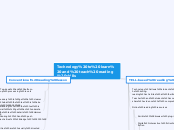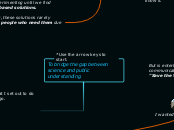Technology to learn and teach reading skills
Conventional reading lesson
Pre-, during-, and post-reading activities (Hedge, 2000)
During-reading activities are usually directed by the teacher
A few students are able to share their answers
There may be some group feedback in class
Teachers may not know difficulties students face when doing during-reading tasks
Teachers may get a ver vague idea as to how students carry out during-reading tasks
Top-down and bottom-up processing levels
Global understanding of the text is also crucial to get an understanding of the text details (Harmer, 2007)
Bottom-up is necessary to get a clearer view of what the text is about (Harmer, 2007)
TELL-based reading lesson
Reading can be combined with listening, speaking, and writing
Graphic organizers (writing) help discover the inner structure of a text
Provide wider and broader perspectives on texts compared to what students gain from just rereading them (Fitzgerald and Shanahan, 2000)
Springboard from which further writing tasks can be done
Examples: EnchantedLearning, Inspiration, and Kidspiration
Show relationships between the information inside texts
Contrasting, comparing, describing, classifying, caus and effect, etc.
Mind maps or entity relationship charts
Reading helps people become good writers (Lenski and Johns, 2007; Crowhurst, 1991)
Reading and writing have differences, but similarities as well (Hudson, 2007)
Similarities
Readers and writers "talk" through a text
Readers and writers try to create an internal text by building up propositions and connecting them with their previous knowledge
Digital texts features which encourage reader-text interaction
However, these multimodal characteristics may result in reading comprehension difficulties.
Readers may decide the course of the story (digital fiction)
Offer non-linear reading sequence
Links to other websites
Embedded video and sound files
Images
Online reading resources
Online newspapers, magazines, journals, courses, etc.
Digital interactive fiction and non-fiction
Nevill et al. (2009) ponts out the benefits for L2 reading skills
Gee (2007) indicates the benefits for L1 reading
Scrible (browser plug-in)
Teacher and students access and share evidence of comprehension
Technology allows students to do the during-reading activitites at their own pace









